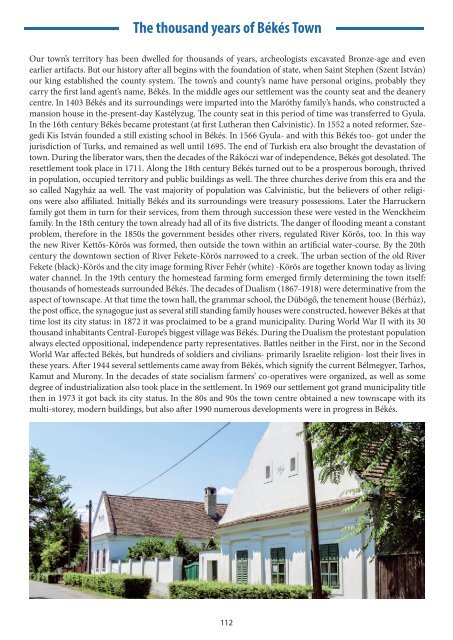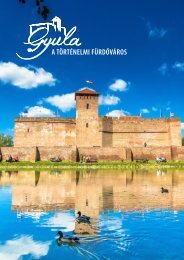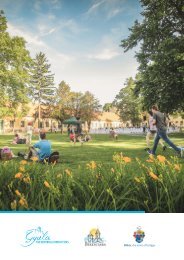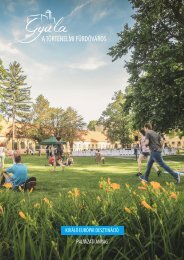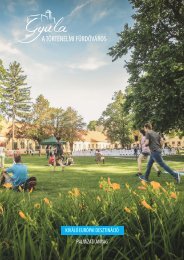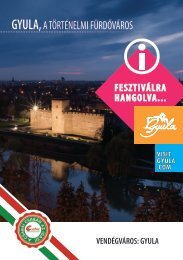eden-kiadvany-06-EN-yumpu
Create successful ePaper yourself
Turn your PDF publications into a flip-book with our unique Google optimized e-Paper software.
The thousand years of Békés Town<br />
Our town’s territory has been dwelled for thousands of years, archeologists excavated Bronze-age and even<br />
earlier artifacts. But our history after all begins with the foundation of state, when Saint Stephen (Szent István)<br />
our king established the county system. The town’s and county’s name have personal origins, probably they<br />
carry the first land agent’s name, Békés. In the middle ages our settlement was the county seat and the deanery<br />
centre. In 1403 Békés and its surroundings were imparted into the Maróthy family’s hands, who constructed a<br />
mansion house in the-present-day Kastélyzug. The county seat in this period of time was transferred to Gyula.<br />
In the 16th century Békés became protestant (at first Lutheran then Calvinistic). In 1552 a noted reformer, Szegedi<br />
Kis István founded a still existing school in Békés. In 1566 Gyula- and with this Békés too- got under the<br />
jurisdiction of Turks, and remained as well until 1695. The end of Turkish era also brought the devastation of<br />
town. During the liberator wars, then the decades of the Rákóczi war of independence, Békés got desolated. The<br />
resettlement took place in 1711. Along the 18th century Békés turned out to be a prosperous borough, thrived<br />
in population, occupied territory and public buildings as well. The three churches derive from this era and the<br />
so called Nagyház aa well. The vast majority of population was Calvinistic, but the believers of other religions<br />
were also affiliated. Initially Békés and its surroundings were treasury possessions. Later the Harruckern<br />
family got them in turn for their services, from them through succession these were vested in the Wenckheim<br />
family. In the 18th century the town already had all of its five districts. The danger of flooding meant a constant<br />
problem, therefore in the 1850s the government besides other rivers, regulated River Körös, too. In this way<br />
the new River Kettős-Körös was formed, then outside the town within an artificial water-course. By the 20th<br />
century the downtown section of River Fekete-Körös narrowed to a creek. The urban section of the old River<br />
Fekete (black)-Körös and the city image forming River Fehér (white) -Körös are together known today as living<br />
water channel. In the 19th century the homestead farming form emerged firmly determining the town itself:<br />
thousands of homesteads surrounded Békés. The decades of Dualism (1867-1918) were determinative from the<br />
aspect of townscape. At that time the town hall, the grammar school, the Dübögő, the tenement house (Bérház),<br />
the post office, the synagogue just as several still standing family houses were constructed, however Békés at that<br />
time lost its city status: in 1872 it was proclaimed to be a grand municipality. During World War II with its 30<br />
thousand inhabitants Central-Europe’s biggest village was Békés. During the Dualism the protestant population<br />
always elected oppositional, independence party representatives. Battles neither in the First, nor in the Second<br />
World War affected Békés, but hundreds of soldiers and civilians- primarily Israelite religion- lost their lives in<br />
these years. After 1944 several settlements came away from Békés, which signify the current Bélmegyer, Tarhos,<br />
Kamut and Murony. In the decades of state socialism farmers’ co-operatives were organized, as well as some<br />
degree of industrialization also took place in the settlement. In 1969 our settlement got grand municipality title<br />
then in 1973 it got back its city status. In the 80s and 90s the town centre obtained a new townscape with its<br />
multi-storey, modern buildings, but also after 1990 numerous developments were in progress in Békés.<br />
112


